Nearly everyone I spoke to about this trip assumed I was going to Africa when I told them I was Guyana bound. Even the Ghanian shuttle bus driver at the Columbus airport misheard me, and thought I'd just come back from his home country. It's an honest mistake, ironically made even more understandable by the physical similarity between Guyana and Africa.
The African cultural influence in Guyana is so strong that sometimes I had a hard time remembering I was in the New World. This lady was cutting grass for her cattle in the marsh in the botanic garden.
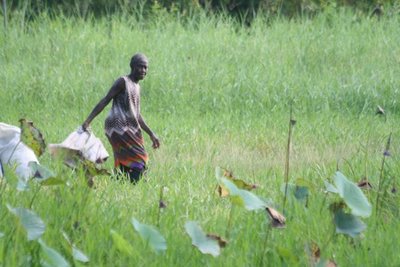 She acknowledges me with a slight smile and keeps at her work. Her cattle may have been blocking traffic at that moment; zebus and other African-blooded cattle wander freely through Georgetown's streets.
She acknowledges me with a slight smile and keeps at her work. Her cattle may have been blocking traffic at that moment; zebus and other African-blooded cattle wander freely through Georgetown's streets.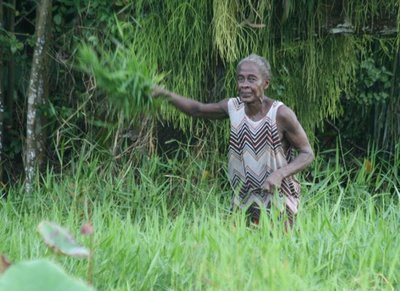 You really have to see it to believe it. The East Indian (Hindu) influence causes traffic to stop for the cattle. People live their lives around them. It's interesting to see cattle living peaceably among people in a fence-free environment, nursing their calves on front lawns and grabbing a bite on a median strip. Around Whipple, if anyone's cattle get out of their pastures, they immediately mend the fence and drive around until they find them and get them back in confinement. In Guyana, the cattle seem to know exactly where they're going and where they want to be, and people just deal with it.
You really have to see it to believe it. The East Indian (Hindu) influence causes traffic to stop for the cattle. People live their lives around them. It's interesting to see cattle living peaceably among people in a fence-free environment, nursing their calves on front lawns and grabbing a bite on a median strip. Around Whipple, if anyone's cattle get out of their pastures, they immediately mend the fence and drive around until they find them and get them back in confinement. In Guyana, the cattle seem to know exactly where they're going and where they want to be, and people just deal with it.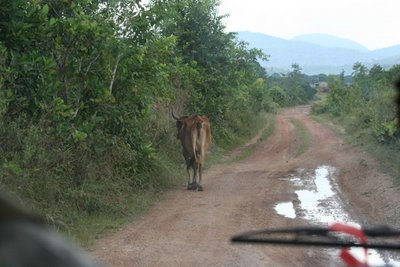 And then there's the Caribbean influence, extremely strong around Georgetown. There are lots of people walking around Georgetown who would draw long stares in America. But then I'm sure we'd draw stares in Georgetown, since I noticed immediately that most Americans outweigh Guyanans by quite a margin. Everyone seemed to be skinny to me; the people, the cattle and the dogs. Prosperity is not necessarily good for our bodies. Rastafarians keep a strict vegetarian diet, and they tended to be even skinnier than other Guyanans I saw.
And then there's the Caribbean influence, extremely strong around Georgetown. There are lots of people walking around Georgetown who would draw long stares in America. But then I'm sure we'd draw stares in Georgetown, since I noticed immediately that most Americans outweigh Guyanans by quite a margin. Everyone seemed to be skinny to me; the people, the cattle and the dogs. Prosperity is not necessarily good for our bodies. Rastafarians keep a strict vegetarian diet, and they tended to be even skinnier than other Guyanans I saw.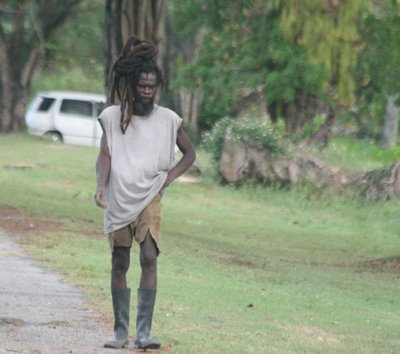 This gentleman is transporting his singing finch (probably of the genus Oryzoborus) to a competition. People trap, keep and trade in wild male finches in order to enter them in singing competitions, which often take place on Sundays in city parks. They place the cages next to one another and see whose bird sings most lustily and most often. Needless to say, this is not a blood sport, but bets are placed, and money changes hands. It beats cockfighting, but does represent a significant drain on wild populations of these little birds.
This gentleman is transporting his singing finch (probably of the genus Oryzoborus) to a competition. People trap, keep and trade in wild male finches in order to enter them in singing competitions, which often take place on Sundays in city parks. They place the cages next to one another and see whose bird sings most lustily and most often. Needless to say, this is not a blood sport, but bets are placed, and money changes hands. It beats cockfighting, but does represent a significant drain on wild populations of these little birds.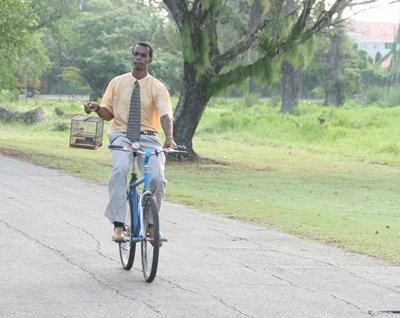
Because I am a curious person, I ventured into a department store in downtown Georgetown during our one two-hour free period in town to have a look around. I offer you this living room set, which for me epitomized how far away I really had come from Ohio. I think I might have spotted Elvis slipping around the corner, doubtless shopping for furnishings for the Jungle Room.
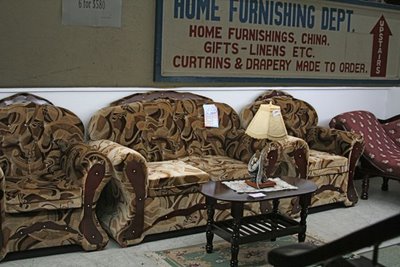 Georgetown lies a frightening seven feet below sea level. It owes its existence to a seawall that completely blocks its view of the (admittedly rather muddy) Caribbean. It's very odd to be able to sense that you're on the coast, but not to be able to see it at all, without climbing a big embankment and peering over a concrete wall. It's also disturbing to contemplate what will happen to Georgetown when global warming causes the inevitable (and possibly rapid) rise in sea level. The Dutch built a system of canals and dikes throughout Georgetown, but they've fallen into some disrepair.
Georgetown lies a frightening seven feet below sea level. It owes its existence to a seawall that completely blocks its view of the (admittedly rather muddy) Caribbean. It's very odd to be able to sense that you're on the coast, but not to be able to see it at all, without climbing a big embankment and peering over a concrete wall. It's also disturbing to contemplate what will happen to Georgetown when global warming causes the inevitable (and possibly rapid) rise in sea level. The Dutch built a system of canals and dikes throughout Georgetown, but they've fallen into some disrepair.  The seawall is a place to gather and walk, and it is also a fabulous advertising opportunity. Every weekend there is a rolling party along the seawall, with sporting events, reggae artists and vendors and food booths.
The seawall is a place to gather and walk, and it is also a fabulous advertising opportunity. Every weekend there is a rolling party along the seawall, with sporting events, reggae artists and vendors and food booths.Parts of the wall have been beautifully decorated by schoolkids. I could do a series of posts on just the wall art itself, if we hadn't been whipping past it at such speed.
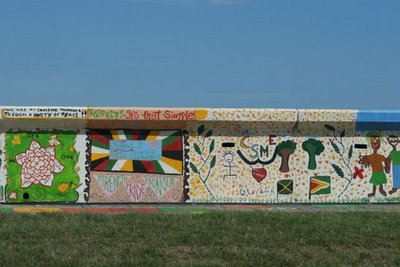 This was a particularly nice passage, doubtless painted by a professional.
This was a particularly nice passage, doubtless painted by a professional. 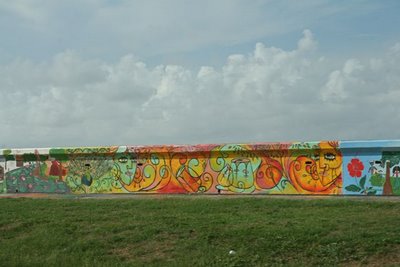 There was some pretty good advertising art on the streets, too.
There was some pretty good advertising art on the streets, too.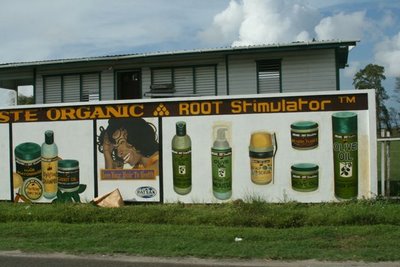 My roots desperately needed stimulation; the soaking humidity rendered my normally bouncy 'do limp as a hot flapjack. It is nice to return from the land of Hair Problems.
My roots desperately needed stimulation; the soaking humidity rendered my normally bouncy 'do limp as a hot flapjack. It is nice to return from the land of Hair Problems.Much of the allure of travel is mystery. I leave you with Smalta
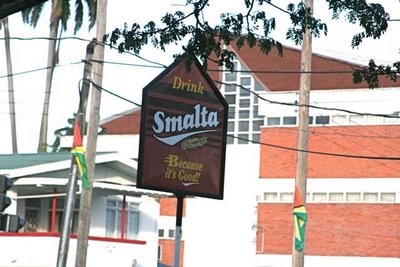 and Cheekies.
and Cheekies.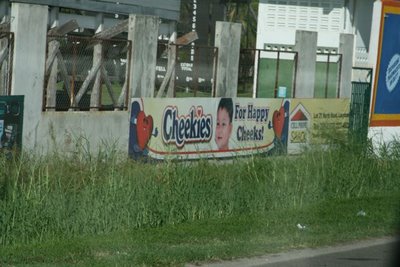






9 comments:
It appears that hair, whether of good days or bad days, has universal concern--and, from the local inhabitants, is grown gracefully LONG!
(surprising in such a climate!)
Your shot of the man on his bike is very telling. He looks so serious and proper. It is very sad that he has a little bird in that cage.
Julie, I have a question for you...
Why does the caged bird sing?
Jared from Denton Texas
P.S. Congrats on getting into the Hog Island Show I gave to my local Ft Worth Audubon chapter last month. The speech went well enough that Dallas Audubon asked me to give it to them next week.
Your scenes certainly do look like Africa.
Love the last sign--Cheekies--for your cheeks. Wha?
Another world. Observing the people of Guyana would be a treat for me - ducking around corners to get their moments in a photograph, like Tim does. A smile from them in return would be priceless. You pay attention and it shows.
Bad hair days make me miserable but I think the culture shock would soften the blow enough to purchase a bandana or hat.
Mary
Indeed, bad hair days are universal! :c) What a living room ensemble you found there.
What a mixture of cultures and traditions, not to mention the birds! Must've been a great trip.
You must have been in sensory overload with all these sights in addition to the birds. Thanks for sharing this trip with us Julie.
Just wanted to say that people in Guyana are called Guyanese...
Post a Comment